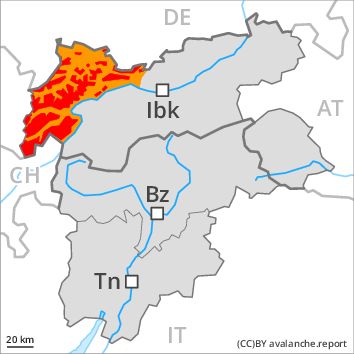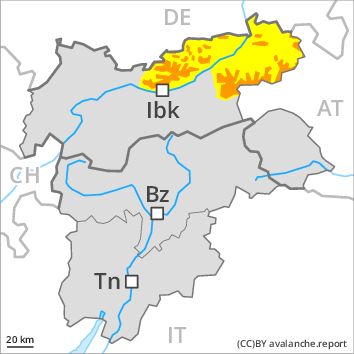Regions
Western Tuxer Alps, Glockturm Range, Grieskogel Mountains, Weißkugel Range, Gurgler Range, Central Stubai Alps, Northern Oetz and Stubai Alps

Danger level
Danger Level 4 - High above 2400m
Danger Level 3 - Considerable above 2400m
Avalanche Problem
Wind-drifted snow above 2400m, N-NE-E-SE-S-SW-W-NW
Gliding snow above the treeline, E-SE-S-SW-W

Fresh wind slabs represent the main danger. Gliding avalanches and wet snow slides are still to be expected.
Significant increase in avalanche danger as a consequence of fresh snow and wind. The fresh wind slabs represent the main danger. The avalanche prone locations for dry avalanches are to be found in particular adjacent to ridgelines above approximately 2400 m. In isolated cases the dry avalanches are medium-sized and easily released.
As the penetration by moisture increases small to medium-sized gliding avalanches and moist snow slides are possible. This applies in particular on steep sunny slopes as well as at low and intermediate altitudes, especially in the regions with a lot of snow. Caution is to be exercised in areas with glide cracks.
Snowpack
dp 6: cold, loose snow and wind
dp 2: gliding snow
Over a wide area 30 to 50 cm of snow, and even more in some localities, will fall above approximately 1000 m. The fresh wind slabs will become increasingly prone to triggering in particular on steep shady slopes above approximately 2400 m. The snowpack will be subject to considerable local variations at high altitudes and in high Alpine regions. At low and intermediate altitudes the snow is moist, also on sunny slopes below approximately 2600 m.
Tendency
Further increase in danger of dry and moist avalanches as a consequence of fresh snow and wind.
Regions
Western Lechtal Alps, Central Lechtal Alps, Western Verwall Mountains, Eastern Verwall Mountains, Allgäu Alps, Silvretta, Samnaun Mountains, Eastern Lechtal Alps - Ammergau Alps, Mieming Mountains

Danger level
Danger Level 4 - High above the treeline
Danger Level 3 - Considerable above the treeline
Avalanche Problem
Wind-drifted snow above the treeline, N-NE-E-SE-S-SW-W-NW
Gliding snow above the treeline, E-SE-S-SW-W

Fresh wind slabs represent the main danger. Gliding avalanches and wet snow slides are to be expected.
Significant increase in avalanche danger as a consequence of fresh snow and stormy weather. The fresh wind slabs represent the main danger. The avalanche prone locations for dry avalanches are to be found in particular adjacent to ridgelines above approximately 2000 m. In some cases the avalanches are large and very easily released.
As the moisture increases small to medium-sized gliding avalanches and moist snow slides are possible. This applies in particular on steep sunny slopes as well as at low and intermediate altitudes, especially in the regions with a lot of snow. Caution is to be exercised in areas with glide cracks.
Snowpack
dp 6: cold, loose snow and wind
dp 2: gliding snow
Over a wide area 50 to 80 cm of snow, and even more in some localities, will fall above approximately 1000 m. The fresh wind slabs will become increasingly prone to triggering in particular on steep shady slopes above approximately 2000 m. The snowpack will be subject to considerable local variations at high altitudes and in high Alpine regions. At low and intermediate altitudes the snow is moist, also on sunny slopes below approximately 2600 m.
Tendency
Further increase in danger of dry and moist avalanches as a consequence of fresh snow and strong wind.
Regions
Eastern Tuxer Alps, Northern Zillertal Alps, Venediger Range

Danger level
Danger Level 4 - High above 2400m
Danger Level 3 - Considerable above 2400m
Avalanche Problem
Wind-drifted snow above 2400m, N-NE-E-SE-S-SW-W-NW
Gliding snow above the treeline, E-SE-S-SW-W

Further increase in avalanche danger as a consequence of fresh snow and wind. Gliding avalanches and wet snow slides are to be expected.
Fresh wind slabs are mostly dangerously large and prone to triggering. Caution is to be exercised in particular adjacent to ridgelines, and elsewhere on very steep shady slopes especially at high altitudes and in high Alpine regions. Dry avalanches can additionally be released in near-surface layers, even by a single winter sport participant.
As the penetration by moisture increases small to medium-sized gliding avalanches and moist snow slides are possible. This applies in particular on steep sunny slopes below approximately 2600 m as well as at low and intermediate altitudes, especially in the regions with a lot of snow.
Snowpack
dp 6: cold, loose snow and wind
dp 2: gliding snow
Over a wide area 40 to 60 cm of snow, and even more in some localities, will fall above approximately 1000 m. The fresh and older wind slabs will become increasingly prone to triggering in particular on steep shady slopes above approximately 2400 m. The snowpack will be subject to considerable local variations at high altitudes and in high Alpine regions.
Faceted weak layers exist in the top section of the snowpack on steep sunny slopes, in particular above approximately 2400 m. At low and intermediate altitudes the snow is moist, also on sunny slopes below approximately 2600 m.
Tendency
Further increase in danger of dry and moist avalanches as a consequence of fresh snow and wind.
Regions
Karwendel Mountains, Brandenberg Alps, Western Kitzbühel Alps, Wilder Kaiser Mountains - Waidring Alps, Eastern Kitzbühel Alps

Danger level
Danger Level 3 - Considerable above the treeline
Danger Level 2 - Moderate above the treeline
Avalanche Problem
Wind-drifted snow above the treeline, N-NE-E-SE-S-SW-W-NW
Gliding snow above the treeline, E-SE-S-SW-W

Fresh wind slabs represent the main danger. Gliding avalanches and moist snow slides are still to be expected.
Fresh wind slabs represent the main danger. The avalanche prone locations are to be found on steep slopes above approximately 1800 m. Caution is to be exercised in particular adjacent to ridgelines as well as on steep slopes. Such avalanche prone locations are widespread and are therefore barely recognisable in the fog.
Snowpack
dp 6: cold, loose snow and wind
dp 2: gliding snow
The fresh wind slabs will become increasingly prone to triggering in all aspects above approximately 1800 m. The snowpack will be moist at low and intermediate altitudes. This also applies on steep sunny slopes at high altitude.
Tendency
Significant increase in avalanche danger as a consequence of fresh snow and wind.
Regions
Latemar, Southern Adamello, Primiero - Pale di S. Martino, Adamello - Presanella, Prealps, Northern Brenta - Peller, Cembra Valley, Bondone and Stivo, Vallarsa, Western Nonsberg Alps, Folgaria - Laverone, Southern Brenta, Fassa Valley, Sole, Pejo and Rabbi, Southern Lagorai, Ledro Valley, Northern Lagorai, Maddalene, Paganella, Marzola - Valsugana, Pine' - Mocheni Valley

Danger level
Danger Level 3 - Considerable above the treeline
Danger Level 2 - Moderate above the treeline
Avalanche Problem
Wind-drifted snow above the treeline, N-NE-E-SE-S-SW-W-NW
Gliding snow above 2400m, N-NE-E-SE-S-SW-W-NW

The wind slabs represent the main danger.
Ski touring and other off-piste activities, including snowshoe hiking, call for meticulous route selection, in particular on steep slopes above approximately 1800 m. Great caution and restraint are advisable. The more recent wind slabs are extensive and can in some cases be released easily. Single winter sport participants can release avalanches very easily, in the regions exposed to heavier precipitation in particular on wind-loaded slopes and. Below approximately 2200 m small and medium-sized gliding avalanches are possible.
Snowpack
The wind slabs are to be found in particular adjacent to ridgelines and in gullies and bowls and generally in the high Alpine regions. They are extensive and prone to triggering. In some cases the wind slabs have bonded still only poorly with the old snowpack. The old snowpack will be moist below approximately 2200 m. As a consequence of the strong northwesterly wind the prevalence and size of the avalanche prone locations will increase on Monday.
Tendency
Gradual increase in danger of dry avalanches as a consequence of fresh snow and strong wind. The northwesterly wind will transport the fresh and old snow. Wind slabs represent the main danger. There is a danger of gliding avalanches, in particular in the regions with a lot of snow in particular below approximately 2200 m.
Regions
Glockner Range, Eastern Deferegger Alps, Schober Mountains, Lienzer Dolomites, Eastern Rieserferner Mountains

Danger level
Danger Level 3 - Considerable above the treeline
Danger Level 2 - Moderate above the treeline
Avalanche Problem
Wind-drifted snow above 2400m, N-NE-E-SE-S-SW-W-NW
Gliding snow above the treeline, E-SE-S-SW-W

Gradual decrease in avalanche danger as a consequence of the ceasing of precipitation. Gliding avalanches and wet snow slides are to be expected even now.
Fresh and somewhat older wind slabs are in many cases quite large and prone to triggering. Caution is to be exercised in particular adjacent to ridgelines, and elsewhere on very steep shady slopes especially at high altitudes and in high Alpine regions. Dry avalanches can additionally be released in near-surface layers, even by a single winter sport participant.
As the penetration by moisture increases small to medium-sized gliding avalanches and moist snow slides are possible. This applies in particular on steep sunny slopes below approximately 2600 m as well as at low and intermediate altitudes, especially in the regions with a lot of snow.
Snowpack
dp 6: cold, loose snow and wind
dp 2: gliding snow
The no longer entirely fresh wind slabs of the last few days are bonding only slowly with the old snowpack. The snowpack will be subject to considerable local variations at high altitudes and in high Alpine regions.
Faceted weak layers exist in the top section of the snowpack on steep sunny slopes, in particular above approximately 2400 m. At low and intermediate altitudes the snow is moist, also on sunny slopes below approximately 2600 m.
Tendency
Gradual decrease in danger of dry avalanches as a consequence of the ceasing of precipitation.
Regions
Sexten Dolomites, Eastern Pfunderer Mountains, Durreck Range, Val Müstair Alps, Western Rieserferner Mountains, Langtaufers, Western Deferegger Alps, Schnals Ridge, Ortler Range, Southern Stubai Alps, Ulten Valley, Southern Zillertal Alps and High Tauern, Eastern Nonsberger Alps, Saldurn-Mastaun Ridge, Northern Dolomites of Fiemme, Texel Mountains, Gröden Dolomites, Sarntal Alps, Prags Dolomites, Western Pfunderer Mountains

Danger level
Danger Level 3 - Considerable above the treeline
Danger Level 2 - Moderate above the treeline
Avalanche Problem
Wind-drifted snow above the treeline, N-NE-E-SE-S-SW-W-NW
Gliding snow above 2400m, N-NE-E-SE-S-SW-W-NW

The wind slabs represent the main danger.
The current avalanche situation calls for experience in the assessment of avalanche danger and careful route selection. Great caution and restraint are advisable. The more recent wind slabs are extensive and can in some cases be released easily. Single winter sport participants can release avalanches very easily, in the regions exposed to heavier precipitation in particular on wind-loaded slopes and. Especially below approximately 2400 m small and medium-sized gliding avalanches are possible.
Snowpack
The wind slabs have formed in particular in the regions exposed to precipitation and generally at high altitudes. They are extensive and prone to triggering. In some cases the wind slabs have bonded still only poorly with the old snowpack. Faceted weak layers exist in the old snowpack in particular adjacent to ridgelines. The old snowpack will be moist below approximately 2200 m. As a consequence of the strong to storm force northwesterly wind the prevalence and size of the avalanche prone locations will increase on Monday.
Tendency
Gradual increase in danger of dry avalanches as a consequence of fresh snow and strong wind. The northwesterly wind will transport the fresh and old snow. Wind slabs represent the main danger. There is a danger of gliding avalanches, in particular in the regions with a lot of snow in particular below approximately 2200 m.







